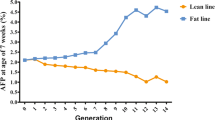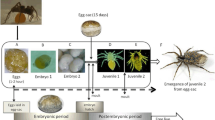Abstract
The development of adipose tissue in the chick embryo was investigated using two groups of fertile eggs which differed by 1.7-fold in their initial yolk lipid levels. The triacylglycerol content of the subcutaneous adipose depot in both groups increased dramatically from day 12 of the 21-day embryonic period, attaining a maximal value just prior to hatching. During this period, the amount of triacylglycerol deposited in the adipose tissue was very highly correlated with the amount of lipid transferred from the yolk. The triacylglycerol content of the depot was also dependent on the initial yolk lipid content. During the hatching period, the amount of adipose triacylglycerol remained approximately constant in the group with the higher initial yolk lipid content but, in the case of the group with the lower initial yolk lipid levels, decreased by approximately 25%. The size distribution of adipocytes isolated from the tissue was determined by computerized image analysis microscopy. The mean adipocyte diameter increased from approximately 6 to 35 μm between days 12 and 19, irrespective of the initial yolk content, although development within the eggs with the lower initial yolk content resulted in a decrease in cell size over the hatching period. Both the triacylglycerol and phospholipid fractions of the isolated adipocytes contained substantial proportions (approximately 6%, w/w) of docosahexaenoic acid (DHA) at days 12 and 14, and lower levels of this fatty acid at the later stages. The amount (mg/depot) of DHA in adipose triacylglycerol decreased dramatically over the hatching period. The amount (mg/brain) of DHA in brain phospholipid increased by more than 5-fold between day 12 of development and hatching. A possible explanation for the data may be that DHA is preferentially mobilized from adipose tissue in order to deliver the fatty acid to the developing neural tissues in a form suitable for uptake.
Similar content being viewed by others
Abbreviations
- DHA:
-
docosahexaenoic acid
References
Noble, R.C., and Cocchi, M. (1990) Lipid Metabolism and the Neonatal Chicken,Prog. Lipid Res. 29, 107–140.
Shand, J.H., West, D.W., McCartney, R.J., Noble, R.C., and Speake, B.K. (1993) The Esterification of Cholesterol in the Yolk Sac Membrane of the Chick Embryo.Lipids 28, 621–625.
Speake, B.K., Noble, R.C., and McCartney, R.J. (1993) Tissue-Specific Changes in Lipid Composition and Lipoprotein Lipase Activity During the Development of the Chick Embryo,Biochim. Biophys. Acta 1165, 263–270.
Shand, J.H., West, D.W., Noble, R.C., and Speake, B.K. (1994) Esterification of Cholesterol in the Liver of the Chick Embryo,Biochim. Biophys. Acta 1213, 224–230.
Tarugi, P., Nicolini, S., Marchi, L., Ballarini, G., and Calandra, S. (1994) Apolipoprotein B Production and Cholesteryl Ester Content in the Liver of the Developing Chick,J. Lipid Res. 35, 2019–2031.
Langslow, D.R., and Lewis, R.J. (1972) The Compositional Development of Adipose Tissue inGallus domesticus, Comp. Biochem. Physiol. 43B, 681–688.
Goodridge, A.G. (1973) On the Relationship Between Fatty Acid Synthesis and the Total Activities of Acetyl CoA Carboxylase and Fatty Acid Synthetase in the Liver of the Prenatal and Early Postnatal Chicken,J. Biol. Chem. 248, 1932–1938.
Langslow, D.R. (1972) The Development of Lipolytic Sensitivity in Isolated Fat Cells ofGallus domesticus During the Foetal Period,Comp. Biochem. Physiol 43B, 689–701.
Anderson, G.J., Connor, W.E., Corliss, J.D., and Lin, D.S. (1989) Modulation of Docosaexaenoic acid Levels in the Brain and Retina of the Newly Hatched Chick,J. Lipid Res. 30, 433–441.
Cherian, G., and Sim, J.S. (1992) Preferential Accumulation of n-3 Fatty Acids in the Brain of Chicks from Eggs Enriched in n-3 Fatty Acids,Poult. Sci. 71, 1658–1668.
Neuringer, M., Anderson, G.J., and Connor, W.E. (1988) The Essentiality of n-3 Fatty Acids for the Development and Function of the Brain and Retina,Annu. Rev. Nutr. 8, 517–541.
Maldjian, A., Noble, R.C., and Speake, B.K. (1993) The Transfer of Docosahexaenoic Acid from the Yolk to the Tissues of the Chick Embryo,Biochem. Soc. Trans. 21, 297S.
Christie, W.W. (1984)Lipid Analysis, pp. 52–56, Pergamon Press, London
Speake, B.K., Noble, R.C., McCartney, R.J., and Ferguson, M.W.J. (1994) Differences in Tissue-Specific Lipid Composition Between Embryos of Wild and Captive Breeding Alligators,J. Zool., Lond., 234, 565–576.
Hausman, G.J. (1985) Comparative Anatomy of Adipose Tissue, inNew Perspectives in Adipose Tissue: Structure, Function and Development (Cryer, A., and Van, R.L.R., eds), pp. 1–21. Butterworths, London.
Donnelly, L.E., Cryer, A., and Butterwith, S.C. (1993) Comparison of the Rates of Proliferation of Adipocyte Precursor Cells Derived from Two-Lines of Chicken Which Differ in Their Rates of Adipose Tissue Development,Br. Poult. Sci. 34, 187–193
Olivercrona, T., and Bengtsson-Olivecrona, G. (1987) Milk Lipoprotein Lipase, inLipoprotein Lipase (Borensztajn, J., ed.) pp. 15–58, Evener, Chicago.
Dhopeshwarkar, G.A., and Mead, J.F. (1973) Uptake and Transport of Fatty Acids into the Brain and the Role of the Blood-Brain Barrier System,Adv. Lipid Res. 11 109–142.
Anderson, G.J., and Connor, W.E. (1988) Uptake of Fatty Acids by the Developing Rat Brain,Lipids 23, 286–290.
Thiès, F., Pillon, C., Moliere, P., Lagarde, M., and Lecerf, J. (1994) Preferential Incorporation ofsn-2 Lyso-PC DHA over Unesterified DHA in the Young Rat Brain,Am. J. Physiol. 267, R1273-R1279.
Scott, B.L., and Bazan, N.G. (1989) Membrane Docosahexaenoate Is Supplied to the Developing Rat Brain by the Liver,Proc. Natl. Acad. Sci., USA 86, 2903–2907.
Li, J., Wetzel, M., and O’Brien, P.J. (1992) Transport of n-3 Fatty Acids from the Intestine to the Retina in Rats.J. Lipid Res. 33, 539–548.
Burdge, G.C., and Postle, A.D. (1994) Hepatic Phospholipid Molecular Species in the Guinea Pig. Adaptations to Pregnancy,Lipids 29, 259–264.
Burdge, G.C., Hunt, A.N., and Postle, A.D. (1994) Mechanisms of Hepatic Phosphatidylcholine Synthesis in the Adult Rat: Effects of Pregnancy,Biochem. J. 303, 941–947.
Crawford, M.A., Doyle, W., Williams, G., and Drury, P.J. (1989) The Role of Fats and EFAs for Energy and Cell Structures in the Growth of Fetus and Neonate, inThe Role of Fats in Human Nutrition (Vergroesen, A.J. and Crawford, M.A., eds.) pp. 81–115, Academic Press, London.
Farquarson, J., Cockburn, F., Patrick, W.A., Jamieson, E.C. and Logan, R.W. (1993) Effect of Diet on Infant Subcutaneous Tissue Triglyceride Fatty Acids,Arch. Dis. Child. 69, 589–593.
Author information
Authors and Affiliations
About this article
Cite this article
Farkas, K., Ratchford, I.A.J., Noble, R.C. et al. Changes in the size and docosahexaenoic acid content of adipocytes during chick embryo development. Lipids 31, 313–321 (1996). https://doi.org/10.1007/BF02529878
Received:
Revised:
Accepted:
Issue Date:
DOI: https://doi.org/10.1007/BF02529878




